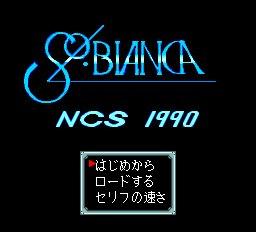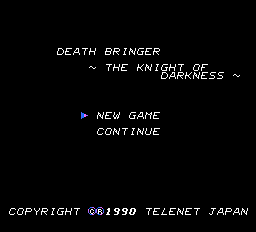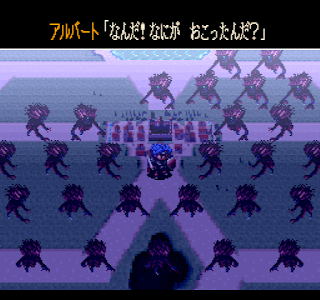Masho Denki La Valeur (魔晶伝記 ラ・ヴァルー)
Released 3/22/1991, published by Kolgado Software
This is another port of a PC game. Unlike in the US, many PC games in Japan were of the JRPG style, but it always seems like there’s something slightly off about them. The game was released for PC in 1989, and although this port adds some voices and maybe music off the CD, it really doesn’t add enough to make it worthwhile.
 |
| Alan, our hero |
The game’s backstory is pretty typical — gather the crystals to save the world. The game immediately starts you at the beginning with no title screen. Your main character, Alan, is in a hobbit village and has to rescue the chief’s daughter from the dark cave to the north. Alan will be the only controllable character throughout the whole game, so the game hearkens back to the style of Dragon Quest 1.
 |
| The status screen |
Alan starts with no money, and the chief gives him a sword. The first task, as in most games of this era, is to grind levels and get money. This is very hard in the beginning, but fortunately the inn is free. Alan is also told that if he can find some rings in the forest he can learn magic, although you won’t actually be able to use it until you finish the first quest and save Sophia. Apparently there are magic spells you can learn from different sources (rings, books, etc) but you can only have one of each type at any one time.
 |
| The first area |
The sound effects are irritating. Any choice produces this annoying buzz sound, and the effect that occurs when you get in a battle is harsh and much louder than the background music.
 |
| vs two Kobolds |
Battles have a strangely abstract feel to them. Even if you encounter more than one monster they’re treated as one. The game just tells you how much damage they all did to you. If you do some damage it will remove a monster and lower their damage, but your attack always hits everyone and can kill more than one monster per turn.
 |
| The weapon and armor store |
You have three types of weapon — slash, pierce, and bludgeon. Each enemy is weak against a particular type, and you can switch weapons during battle. I’m hard pressed to say this adds any real “strategy” to the game, though. It’s just a 1-to-1 correspondence between monster and damage type, so there’s no real strategic choices to be made.
There is a limit to how much you can level in each area before the enemies start giving you 0 exp. The first area has a level limit of 3. After reaching that point I fought the first boss, trying to get some moss to give to a treant in the area for a lantern as a reward. The boss is weak to piercing, but even at level 3 with all the equipment from the town I could not survive to defeat the boss. Eventually I found out there was a stronger shield near the boss, and with this I was able to beat the boss the turn before I would have died.
 |
| The first boss |
This seems to turn the fights into more of a puzzle than an actual RPG combat. Since you have no real options in battle, it’s entirely up to your stats vs the enemy stats whether you die or survive. Maybe when you can use magic it will free things up a bit more, but since it’s always just you alone, and the level limit is strict, I imagine this sort of situation occurs in every boss fight.
At least dying doesn’t send you back to your last save, it just sends you back to the last time you entered a new area.
 |
| Feeding the rats |
With the lantern I could enter the cave. Here I had to find a mushroom to give to some rats, which required extinguishing the lantern to see it. The rats told me where to find a canoe, which let me explore the dungeon rivers.
 |
| Exploring in a canoe |
Enemies do enough damage that I had to stock up on 50+ of the heal items from town just to make a fair exploration of the cave. I didn’t find the boss so I turned back to get more, and this is where I stopped. It’s possible that this game might improve a bit with the introduction of magic, but I doubt it would improve enough to make it really worth playing. The ear-grating sound effects and the slow, forced grinding are a big pain.















































